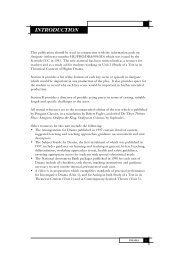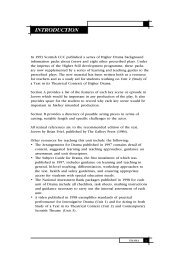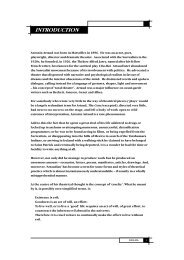PDF file: History - Advanced Higher - Germany - Education Scotland
PDF file: History - Advanced Higher - Germany - Education Scotland
PDF file: History - Advanced Higher - Germany - Education Scotland
Create successful ePaper yourself
Turn your PDF publications into a flip-book with our unique Google optimized e-Paper software.
All his ‘actions’ from the Dawes Plan to the Young Plan must be seen in this light.<br />
Moreover Stressemann never forgot that he would have to satisfy French demands for<br />
security to achieve his goals. With his death in 1929 there is no doubt that successive<br />
Chancellors, namely Bruning, von Papen and Schleicher adopted a more assertive and<br />
aggressive foreign policy.<br />
SECTION 3: HISTORIOGRAPHY OF THE THIRD REICH - 1970S-2000<br />
Over fifty years after its collapse, the legacy of the Third Reich continues to haunt the<br />
German people and the German historical profession. It is even debatable if they will<br />
ever be able to master the Nazi past – the so-called Vergangenheitsbewaltigung (See<br />
Ian Kershaw, The Nazi Dictatorship, 1993, p.1). Some historians believe that the<br />
academic and intellectual tools of the historian are simply inadequate to deal with a<br />
phenomenon that was largely irrational. They see it as impossible to give an adequate<br />
explanation of Nazism. It is certainly true that the history of <strong>Germany</strong> between 1933<br />
and 1939, and indeed up to 1945, is more a matter of contentious and heated debate<br />
amongst historians than the history of <strong>Germany</strong> between 1918 and 1933.<br />
The issue of continuity and change continues to be a dominant theme when placing<br />
the Third Reich in a wider historical context in German history. Historians still argue<br />
over the extent to which Hitler and his movement was the logical culmination of<br />
German history extending back beyond the Weimar years into the nineteenth century<br />
and even into the more distant past. A consensus view largely prevails that the rise of<br />
Nazism can be placed in a short-term (for example the effects of World War I, the<br />
weaknesses of the Weimar Republic, and the effects of the Great Depression) and<br />
long-term (for example the effects of industrialisation and the political legacy of<br />
Bismarck) context linked to the political machinations which, in December 1932 and<br />
January 1933, brought the Chancellorship to Hitler. Disagreements continue to<br />
manifest themselves away from this bigger picture. It is highly unlikely that the issue<br />
of continuity and change will go away. Historians continue to be fascinated and<br />
intrigued by this topic. This continuing fascination is discussed at some length in a<br />
recent study by Richard Evans (Rethinking German <strong>History</strong>, 1990). The pioneering<br />
work of Fritz Fischer (<strong>Germany</strong>’s Aims in the First World War 1966 and also War of<br />
Illusions, 1973) continues to influence German historical scholarship in the field of<br />
continuity and change. The continuing relevance and topicality of his work was<br />
reflected in the translation into English, by an Australian historian Roger Fletcher, of<br />
his famous polemical essay Bundnis der Eliten (From Kaiserreich to Third Reich<br />
Elements of Continuity in German <strong>History</strong> 1871-1945, 1986).<br />
The place of Hitler in the history of the Third Reich continues to dominate much<br />
historical scholarship on the period between 1933 and 1945. The question is<br />
continually asked how important is Adolf Hitler to an understanding of the history of<br />
the Third Reich? The last two decades of the twentieth century witnessed the debate<br />
between the ‘intentionalist’ and ‘structuralist’ historians as to the central importance<br />
or otherwise of Hitler. The ‘intentionalists’ argued that as an individual Hitler was<br />
pivotal to an understanding of the history of the Third Reich. Thus Klaus Hildebrand<br />
argued that Hitler’s pathological anti-Semitism led to the annihilation of European<br />
Jewry because it was his ultimate ‘intention’ to exterminate the Jews. (See also G. L.<br />
Mosse, The Crisis of German Ideology, 1964). In terms of foreign policy Hitler’s<br />
ideological goals, outlined in Mein Kampf and elsewhere, in the early 1920s, shaped<br />
his actions in the 1930s and 1940s.<br />
<strong>History</strong>: <strong>Germany</strong>: Versailles to the Outbreak of World War II - 1918-1939 (AH) 45
















